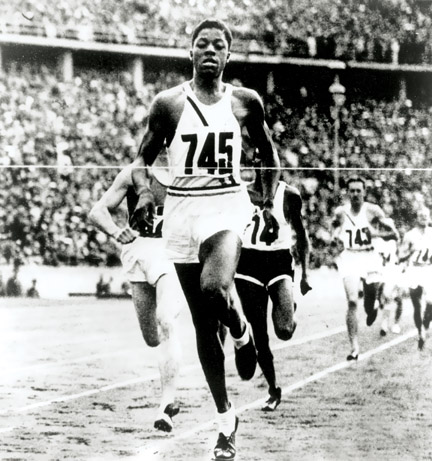Woodruff Highlighted in Exhibition at Holocaust Museum

John Woodruff crossing the finish line at the 1936 Olympic Games in Berlin
The dramatic 1936 Olympic victory of late Pitt alumnus and track star John Woodruff —as well as the actual Olympic gold medal he received for winning the 800-meter-race in the 1936 games—are highlighted in a new special exhibition, The Nazi Olympics: Berlin 1936, at the U.S. Holocaust Memorial and Museum in Washington, D.C. The 1936 gold medal has been at the Pitt library since 1990, when Woodruff donated it to the University.
The show runs through Aug. 17 in the Kimmel-Rowan Gallery at the museum, 100 Raoul Wallenberg Place, S.W., in Washington.
The exhibition recounts the history of the 1936 Olympic Games, which Adolf Hitler’s Nazi dictatorship exploited by downplaying the Third Reich’s racist, militaristic character and attempting to project the illusion of a peace-loving, tolerant Germany. There was talk of an Olympic boycott, but some Black newspapers of the era opposed the idea; Journalists at those papers felt it was hypocritical to boycott the Berlin Olympics without first addressing the problem of discrimination in the United States against Black athletes. Ultimately, 18 Black athletes competed, 16 men and two women, triple the number that had competed in the 1932 Olympic Games in Los Angeles. The 1936 group included Jesse Owens, who ended up winning four gold medals, a record at that time.
A lanky 21-year-old who lacked international running experience, Woodruff got boxed in by veteran runners after the 1936 800-meter race’s first 300 meters. Realizing he would be disqualified if he fouled another runner, he did the unthinkable—he stopped running, moved over to the track’s third lane, let the other runners pass him by, and then began again. As he took off from the back of the pack, his nine-foot stride lengthened, and he passed one rival after another. He was leading the pack when the finish line came into view, and he sprinted forward, breaking the tape at 1:52.9. The New York Herald Tribune called Woodruff’s stop-and-restart technique the “most daring move ever seen on a track.”
Woodruff died on Oct. 30, 2007, at age 92. According to The New York Times, he was the last survivor of the 12 U.S. men who won track and field gold medals at the 1936 Olympics.
Woodruff received the Bachelor of Arts degree in sociology from Pitt in 1939. In October 2006, he visited his alma mater for the last time to be honored during Homecoming events for the 70th anniversary of his storied Olympic victory.
The Nazi Olympics: Berlin 1936 originally opened at the Holocaust Museum to mark the 60th anniversary of the Berlin Games and to coincide with the 1996 Olympic Games in Atlanta. It re-opened last month with some new additions, including Woodruff’s gold medal, which will be returned to Pitt when the exhibition closes; the medal will be housed in a new exhibition display at Pitt’s Hillman Library this fall. This summer’s D.C. exhibition also features a videotaped interview with Woodruff, in which he described the discrimination he faced after returning to America as an Olympic champion.
“After the Olympics, we had a track meet to run at Annapolis, at the Naval Academy. Now here I am, an Olympic champion, and they told the coach that I couldn’t run. I couldn’t come. So I had to stay home, because of discrimination. That let me know just what the situation was. Things hadn’t changed,” Woodruff explained in the interview.
During Woodruff’s final visit to the University, at the Oct. 20, 2006, Varsity Letter Club Annual Dinner, Pitt Chancellor Mark A. Nordenberg delivered remarks honoring Woodruff and then addressed him personally, saying, “John, you and I now have known each other for a number of years, and you never have mentioned that [Naval Academy] incident to me. In fact, I do not know if I ever would have learned about it, if I had not been preparing for your homecoming. But speaking, both personally and for the University of Pittsburgh, I want to apologize to you—and I feel certain that, if those responsible for leading our University 70 years ago were here today, they would stand with me and join me in this expression of regret.”
To tour an online version of this exhibition, visit www.ushmm.org/naziolympics.
Other Stories From This Issue
On the Freedom Road

Follow a group of Pitt students on the Returning to the Roots of Civil Rights bus tour, a nine-day, 2,300-mile journey crisscrossing five states.
Day 1: The Awakening
Day 2: Deep Impressions
Day 3: Music, Montgomery, and More
Day 4: Looking Back, Looking Forward
Day 5: Learning to Remember
Day 6: The Mountaintop
Day 7: Slavery and Beyond
Day 8: Lessons to Bring Home
Day 9: Final Lessons

